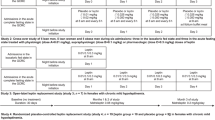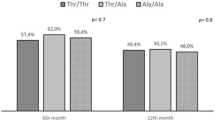Abstract
Background and aims:
Obesity is associated with a blunted β-adrenoceptor-mediated lipolysis and fat oxidation. We investigated whether polymorphisms in codon 16, 27 and 164 of the β2-adrenoceptor gene (ADRB2) and exon 10 of the G protein β3-subunit gene (GNB3) are associated with alterations in in vivo lipolysis and fat oxidation.
Design and methods:
Sixty-five male and 43 female overweight and obese subjects (body mass index (BMI) range: 26.1–48.4 kg/m2) were included. Energy expenditure (EE), respiratory quotient (RQ), circulating free fatty acid (FFA) and glycerol levels were determined after stepwise infusion of increasing doses of the non-selective β-agonist isoprenaline (ISO).
Results:
In women, the Arg16 allele of the ADRB2 gene was associated with a blunted increase in circulating FFA, glycerol and a decreased fat oxidation during ISO stimulation. In men, the Arg16 allele was significantly associated with a blunted increase in FFA but not in glycerol or fat oxidation.
Conclusion:
These results suggest that genetic variation in the ADRB2 gene is associated with disturbances in in vivo β-adrenoceptor-mediated lipolysis and fat oxidation during β-adrenergic stimulation in overweight and obese subjects; these effects are influenced by gene–gender interactions.
This is a preview of subscription content, access via your institution
Access options
Subscribe to this journal
Receive 12 print issues and online access
$259.00 per year
only $21.58 per issue
Buy this article
- Purchase on Springer Link
- Instant access to full article PDF
Prices may be subject to local taxes which are calculated during checkout


Similar content being viewed by others
References
Blaak EE, Van Baak MA, Kemerink GJ, Pakbiers MT, Heidendal GA, Saris WH . Beta-adrenergic stimulation of skeletal muscle metabolism in relation to weight reduction in obese men. Am J Physiol 1994; 267 (2 Part 1): E316–E322.
Blaak EE, Saris WH, Wolffenbuttel BH . Substrate utilization and thermogenic responses to beta-adrenergic stimulation in obese subjects with NIDDM. Int J Obes Relat Metab Disord 1999; 23: 411–418.
Blaak EE, van Aggel-Leijssen DP, Wagenmakers AJ, Saris WH, van Baak MA . Impaired oxidation of plasma-derived fatty acids in type 2 diabetic subjects during moderate-intensity exercise. Diabetes 2000; 49: 2102–2107.
Blaak EE, Van Baak MA, Kemerink GJ, Pakbiers MT, Heidendal GA, Saris WH . Beta-adrenergic stimulation of energy expenditure and forearm skeletal muscle metabolism in lean and obese men. Am J Physiol 1994; 267 (2 Part 1): E306–E315.
Schiffelers SL, Blaak EE, Baarends EM, Van Baak MA, Saris WH, Wouters EF et al. Beta-adrenoceptor-mediated thermogenesis and lipolysis in patients with chronic obstructive pulmonary disease. Am J Physiol Endocrinol Metab 2001; 280: E357–E364.
Reynisdottir S, Wahrenberg H, Carlstrom K, Rossner S, Arner P . Catecholamine resistance in fat cells of women with upper body obesity due to decreased expression of beta 2-adrenoceptors. Diabetologia 1994; 37: 428–435.
Kobilka BK, MacGregor C, Daniel K, Kobilka TS, Caron MG, Lefkowitz RJ . Functional activity and regulation of human beta 2-adrenergic receptors expressed in Xenopus oocytes. J Biol Chem 1987; 262: 15796–15802.
Kobilka BK, Frielle T, Dohlman HG, Bolanowski MA, Dixon RA, Keller P et al. Delineation of the intronless nature of the genes for the human and hamster beta 2-adrenergic receptor and their putative promoter regions. J Biol Chem 1987; 262: 7321–7327.
Liggett SB . Pharmacogenetics of beta-1- and beta-2-adrenergic receptors. Pharmacology 2000; 61: 167–173.
Leineweber K, Brodde OE . Beta2-adrenoceptor polymorphisms: relation between in vitro and in vivo phenotypes. Life Sci 2004; 74: 2803–2814.
Green SA, Turki J, Innis M, Liggett SB . Amino-terminal polymorphisms of the human beta 2-adrenergic receptor impart distinct agonist-promoted regulatory properties. Biochemistry 1994; 33: 9414–9419.
Bengtsson K, Orho-Melander M, Melander O, Lindblad U, Ranstam J, Rastam L et al. Beta(2)-adrenergic receptor gene variation and hypertension in subjects with type 2 diabetes. Hypertension 2001; 37: 1303–1308.
Kim SH, Kim DJ, Seo IA, Min YK, Lee MS, Kim KW et al. Significance of beta2-adrenergic receptor gene polymorphism in obesity and type 2 diabetes mellitus in Korean subjects. Metabolism 2002; 51: 833–837.
Iwamoto N, Ogawa Y, Kajihara S, Hisatomi A, Yasutake T, Yoshimura T et al. Gln27Glu beta2-adrenergic receptor variant is associated with hypertriglyceridemia and the development of fatty liver. Clin Chim Acta 2001; 314: 85–91.
Ukkola O, Rankinen T, Weisnagel SJ, Sun G, Perusse L, Chagnon YC et al. Interactions among the alpha2-, beta2-, and beta3-adrenergic receptor genes and obesity-related phenotypes in the Quebec family study. Metabolism 2000; 49: 1063–1070.
Large V, Hellstrom L, Reynisdottir S, Lonnqvist F, Eriksson P, Lannfelt L et al. Human beta-2 adrenoceptor gene polymorphisms are highly frequent in obesity and associate with altered adipocyte beta-2 adrenoceptor function. J Clin Invest 1997; 100: 3005–3013.
Hellstrom L, Large V, Reynisdottir S, Wahrenberg H, Arner P . The different effects of a Gln27Glu beta 2-adrenoceptor gene polymorphism on obesity in males and in females. J Intern Med 1999; 245: 253–259.
Meirhaeghe A, Helbecque N, Cottel D, Amouyel P . Impact of polymorphisms of the human beta2-adrenoceptor gene on obesity in a French population. Int J Obes Relat Metab Disord 2000; 24: 382–387.
Meirhaeghe A, Helbecque N, Cottel D, Amouyel P . Beta2-adrenoceptor gene polymorphism, body weight, and physical activity. Lancet 1999; 353: 896.
Mori Y, Kim-Motoyama H, Ito Y, Katakura T, Yasuda K, Ishiyama-Shigemoto S et al. The Gln27Glu beta2-adrenergic receptor variant is associated with obesity due to subcutaneous fat accumulation in Japanese men. Biochem Biophys Res Commun 1999; 258: 138–140.
Ishiyama-Shigemoto S, Yamada K, Yuan X, Ichikawa F, Nonaka K . Association of polymorphisms in the beta2-adrenergic receptor gene with obesity, hypertriglyceridaemia, and diabetes mellitus. Diabetologia 1999; 42: 98–101.
Oomen JM, van Rossum CT, Hoebee B, Saris WH, van Baak MA . Beta2-adrenergic receptor polymorphisms and salbutamol-stimulated energy expenditure. J Clin Endocrinol Metab 2005; 90: 2301–2307.
Green SA, Cole G, Jacinto M, Innis M, Liggett SB . A polymorphism of the human beta 2-adrenergic receptor within the fourth transmembrane domain alters ligand binding and functional properties of the receptor. J Biol Chem 1993; 268: 23116–23121.
Green SA, Rathz DA, Schuster AJ, Liggett SB . The Ile164 beta(2)-adrenoceptor polymorphism alters salmeterol exosite binding and conventional agonist coupling to G(s). Eur J Pharmacol 2001; 421: 141–147.
Hoffstedt J, Iliadou A, Pedersen NL, Schalling M, Arner P . The effect of the beta(2) adrenoceptor gene Thr164Ile polymorphism on human adipose tissue lipolytic function. Br J Pharmacol 2001; 133: 708–712.
Siffert W, Rosskopf D, Siffert G, Busch S, Moritz A, Erbel R et al. Association of a human G-protein beta3 subunit variant with hypertension. Nat Genet 1998; 18: 45–48.
Patten JL, Johns DR, Valle D, Eil C, Gruppuso PA, Steele G et al. Mutation in the gene encoding the stimulatory G protein of adenylate cyclase in Albright's hereditary osteodystrophy. N Engl J Med 1990; 322: 1412–1419.
Carel JC, Le Stunff C, Condamine L, Mallet E, Chaussain JL, Adnot P et al. Resistance to the lipolytic action of epinephrine: a new feature of protein Gs deficiency. J Clin Endocrinol Metab 1999; 84: 4127–4131.
Schunkert H, Hense HW, Doring A, Riegger GA, Siffert W . Association between a polymorphism in the G protein beta3 subunit gene and lower renin and elevated diastolic blood pressure levels. Hypertension 1998; 32: 510–513.
Benjafield AV, Jeyasingam CL, Nyholt DR, Griffiths LR, Morris BJ . G-protein beta3 subunit gene (GNB3) variant in causation of essential hypertension. Hypertension 1998; 32: 1094–1097.
Siffert W, Forster P, Jockel KH, Mvere DA, Brinkmann B, Naber C et al. Worldwide ethnic distribution of the G protein beta3 subunit 825 T allele and its association with obesity in Caucasian, Chinese, and Black African individuals. J Am Soc Nephrol 1999; 10: 1921–1930.
Dong Y, Zhu H, Wang X, Dalageorgou C, Carter N, Spector TD et al. Obesity reveals an association between blood pressure and the G-protein beta3-subunit gene: a study of female dizygotic twins. Pharmacogenetics 2004; 14: 419–427.
Hauner H, Meier M, Jockel KH, Frey UH, Siffert W . Prediction of successful weight reduction under sibutramine therapy through genotyping of the G-protein beta3 subunit gene (GNB3) C825T polymorphism. Pharmacogenetics 2003; 13: 453–459.
Hegele RA, Anderson C, Young TK, Connelly PW . G-protein beta3 subunit gene splice variant and body fat distribution in Nunavut Inuit. Genome Res 1999; 9: 972–977.
Ryden M, Faulds G, Hoffstedt J, Wennlund A, Arner P . Effect of the (C825T) Gbeta(3) polymorphism on adrenoceptor-mediated lipolysis in human fat cells. Diabetes 2002; 51: 1601–1608.
Siri WE . The gross composition of the body. Adv Biol Med Phys 1956; 4: 239–280.
Devlin B, Risch N . A comparison of linkage disequilibrium measures for fine-scale mapping. Genomics 1995; 29: 311–322.
Eriksson P, Dahlman I, Ryden M, Hoffstedt J, Arner P . Relationship between beta-2 adrenoceptor gene haplotypes and adipocyte lipolysis in women. Int J Obes Relat Metab Disord 2004; 28: 185–190.
Drysdale CM, McGraw DW, Stack CB, Stephens JC, Judson RS, Nandabalan K et al. Complex promoter and coding region beta 2-adrenergic receptor haplotypes alter receptor expression and predict in vivo responsiveness. Proc Natl Acad Sci USA 2000; 97: 10483–10488.
Schaid DJ, Jacobsen SJ . Biased tests of association: comparisons of allele frequencies when departing from Hardy–Weinberg proportions. Am J Epidemiol 1999; 149: 706–711.
Blaak EE, van Baak MA, Saris WH . Beta-adrenergically stimulated fat oxidation is diminished in middle-aged compared to young subjects. J Clin Endocrinol Metab 1999; 84: 3764–3769.
Kanaley JA, Cryer PE, Jensen MD . Fatty acid kinetic responses to exercise. Effects of obesity, body fat distribution, and energy-restricted diet. J Clin Invest 1993; 92: 255–261.
Blaak E . Gender differences in fat metabolism. Curr Opin Clin Nutr Metab Care 2001; 4: 499–502.
Arner P . Catecholamine-induced lipolysis in obesity. Int J Obes Relat Metab Disord 1999; 23 (Suppl 1): 10–13.
Blaak EE, Schiffelers SL, Saris WH, Mensink M, Kooi ME . Impaired beta-adrenergically mediated lipolysis in skeletal muscle of obese subjects. Diabetologia 2004; 47: 1462–1468.
Dallongeville J, Helbecque N, Cottel D, Amouyel P, Meirhaeghe A . The Gly16—>Arg16 and Gln27—>Glu27 polymorphisms of beta2-adrenergic receptor are associated with metabolic syndrome in men. J Clin Endocrinol Metab 2003; 88: 4862–4866.
Hagstrom-Toft E, Bolinder J, Ungerstedt U, Arner P . A circadian rhythm in lipid mobilization which is altered in IDDM. Diabetologia 1997; 40: 1070–1078.
Bruck H, Leineweber K, Buscher R, Ulrich A, Radke J, Insel PA et al. The Gln27Glu beta2-adrenoceptor polymorphism slows the onset of desensitization of cardiac functional responses in vivo. Pharmacogenetics 2003; 13: 59–66.
Acknowledgements
This study was supported by a research grant from The Netherlands Association for Scientific Research (NWO) to EE Blaak and Swedish Research Council to P Arner.
Author information
Authors and Affiliations
Corresponding author
Rights and permissions
About this article
Cite this article
Jocken, J., Blaak, E., Schiffelers, S. et al. Association of a beta-2 adrenoceptor (ADRB2) gene variant with a blunted in vivo lipolysis and fat oxidation. Int J Obes 31, 813–819 (2007). https://doi.org/10.1038/sj.ijo.0803499
Received:
Revised:
Accepted:
Published:
Issue Date:
DOI: https://doi.org/10.1038/sj.ijo.0803499
Keywords
This article is cited by
-
Obesity-induced and weight-loss-induced physiological factors affecting weight regain
Nature Reviews Endocrinology (2023)
-
Environmental Factors and Beta2‐Adrenergic Receptor Polymorphism: Influence on the Energy Expenditure and Nutritional Status of Obese Women
Lipids (2015)
-
Associations between the GNB3 C825T polymorphism and obesity-related metabolic risk factors in Korean obese women
Journal of Endocrinological Investigation (2014)
-
Formoterol, a highly β2-selective agonist, increases energy expenditure and fat utilisation in men
International Journal of Obesity (2013)



